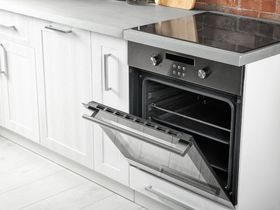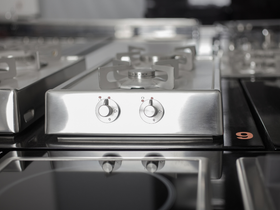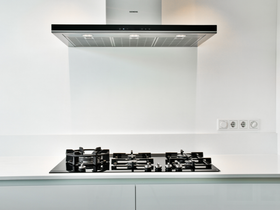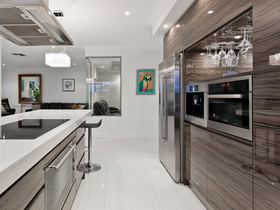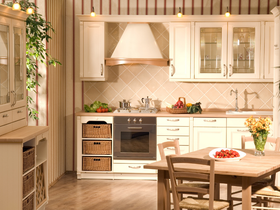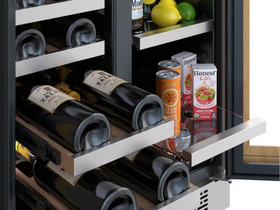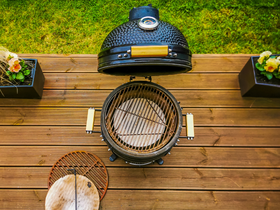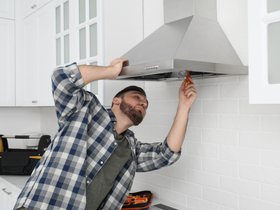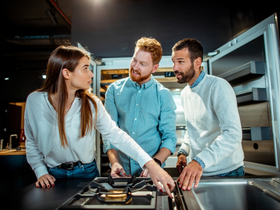
Professional-Style Ranges: What Makes Them Different (and Who Should Buy One)
Thinking about upgrading to a commercial-style range for your home? Learn what sets pro-style ranges apart — and whether they're the right choice for your kitchen.
I. Introduction: The Rise of the Pro-Style Kitchen
Walk into any high-end kitchen showroom, and you'll notice something: those massive, stainless steel ranges that look like they belong in a restaurant kitchen are everywhere. Professional-style ranges have become the ultimate kitchen status symbol, but they're also genuinely transforming how serious home cooks approach their craft.
The appeal is obvious – these ranges promise restaurant-grade performance in your home kitchen. They look impressive, cook with serious power, and suggest that whoever owns them takes cooking very seriously. But behind the gleaming stainless steel and industrial-strength knobs, there's a real question: are they actually right for your kitchen and cooking style?
Professional-style ranges represent a fascinating middle ground between true commercial equipment (which isn't safe or legal for home use) and standard residential appliances. They bring restaurant-level performance to home kitchens while including safety features and design considerations that make them practical for everyday use.
This guide will walk you through what actually makes professional-style ranges different, who should consider buying one, and, perhaps most importantly, who probably shouldn't. While these ranges can absolutely transform your cooking experience, they're not the right choice for every kitchen or every cook.
II. What Is a Professional-Style Range?
Professional-style ranges are essentially residential appliances designed to deliver commercial-grade cooking performance. They're built to look and perform like the ranges you'd find in restaurant kitchens, but with safety features and design modifications that make them appropriate for home use.
Built to Mimic Commercial Ranges, But Safe for Residential Use
The commercial inspiration: Restaurant ranges are built for speed, power, and durability. They need to handle constant use, high heat, and demanding cooking techniques. Professional-style home ranges capture this performance while adding features like automatic ignition, safety shut-offs, and residential-appropriate ventilation requirements.
Home-friendly modifications: Unlike true commercial equipment, pro-style ranges include features like oven insulation (so your kitchen doesn't turn into a sauna), automatic pilot lights, and controls designed for home cooks rather than professional chefs working in fast-paced environments.
Heavier Construction, Higher Heat, More Burners
Built like tanks: Professional-style ranges are substantially heavier and more robust than standard residential ranges. They're designed to handle years of intensive use without performance degradation.
Serious heat output: While standard residential gas ranges might max out around 15,000-18,000 BTU per burner, professional-style ranges commonly offer 20,000-25,000 BTU burners, with some specialty burners going even higher.
More cooking real estate: These ranges typically offer 4-8 burners (compared to 4-5 on standard ranges), often with different burner types for different cooking techniques.
No Digital Frills — Just Performance
Analog simplicity: Most professional-style ranges focus on mechanical controls rather than digital displays. Heavy-duty knobs, simple igniters, and straightforward operation are the norm.
Performance over convenience: You won't find features like WiFi connectivity, smartphone apps, or elaborate digital displays. The focus is entirely on cooking performance and durability.
Professional aesthetics: The design language is deliberately utilitarian – stainless steel construction, industrial-style knobs, and a no-nonsense appearance that says "serious cooking happens here."
III. Key Differences Compared to Standard Residential Ranges
Understanding what sets professional-style ranges apart helps explain both their appeal and their limitations.
A. Power and Performance
Higher BTU output: The most obvious difference is heat output. Professional-style ranges deliver significantly more power than standard residential models.
Standard residential gas ranges: 5,000-18,000 BTU per burner Professional-style ranges: 15,000-25,000+ BTU per burner
Rapid boiling and intense heat: This extra power means you can bring large pots of water to a boil much faster, achieve proper wok cooking temperatures, and get the kind of searing heat that creates restaurant-quality results.
Superior low-heat control: Counterintuitively, many pro-style ranges are also better at very low heat. They often include simmer burners that can maintain gentle heat for delicate sauces and slow cooking.
Ideal cooking techniques: The combination of high and low heat control makes these ranges perfect for techniques like:
- High-heat searing and browning
- Wok cooking and stir-frying
- Large-batch cooking
- Delicate sauce work
- Rapid boiling for pasta and vegetables
B. Size and Cooking Capacity
Wider footprints: While standard ranges are typically 30 inches wide, professional-style ranges commonly come in 36", 48", and even 60"+ widths.
More burners: With the extra width comes more cooking space – often 6-8 burners compared to 4-5 on standard ranges.
Larger oven capacity: Professional-style ranges typically offer larger oven cavities, and many include double ovens for maximum cooking flexibility.
Multiple cooking zones: Many models include specialized areas like griddles, grills, or French tops alongside standard burners.
C. Design and Materials
All stainless steel construction: Professional-style ranges are typically built entirely from commercial-grade stainless steel, both for durability and aesthetics.
Industrial design elements: Heavy-duty knobs, substantial grates, and utilitarian styling that emphasizes function over decoration.
Front-facing controls: Unlike many residential ranges with controls on a back panel, pro-style ranges typically have controls on the front for easier access and a cleaner look.
Open burner design: Many professional-style ranges use open burners (like commercial ranges) rather than the sealed burners common on residential models.
D. Installation Requirements
Professional installation often required: The combination of high BTU output, heavy weight, and specific ventilation needs usually requires professional installation.
Upgraded ventilation necessary: High-BTU cooking requires serious ventilation – often 600-1200+ CFM range hoods compared to 300-500 CFM for standard ranges.
Space and structural considerations: These ranges are typically deeper and heavier than standard models, potentially requiring cabinet modifications or structural reinforcement.
Utility requirements: High-BTU gas ranges may require larger gas lines, while electric models need appropriate high-voltage connections.
| Feature | Standard Residential | Professional-Style |
|---|---|---|
| Width | 30-36 inches | 36-60+ inches |
| BTU Range | 5,000-18,000 | 15,000-25,000+ |
| Burners | 4-5 | 4-8+ |
| Weight | 200-300 lbs | 400-600+ lbs |
| Installation | Often DIY-friendly | Usually requires professional |
| Ventilation Needs | 300-500 CFM | 600-1200+ CFM |
IV. Who Should Buy a Professional-Style Range?
Professional-style ranges aren't for everyone, but for the right cook in the right kitchen, they can be transformative.
Avid Home Chefs Who Cook Frequently
If you cook daily, The extra power and capacity make everyday cooking more efficient and enjoyable. Tasks that take forever on standard ranges happen quickly on pro-style models.
If you love challenging recipes: Techniques that are difficult or impossible on standard ranges – like proper stir-frying or high-heat searing – become accessible.
If cooking is your passion: For people who genuinely love to cook and want the best tools available, the performance difference is immediately noticeable and consistently rewarding.
Large Households That Need More Capacity
If you regularly cook for 6+ people, the extra burners and oven capacity make preparing large meals much more manageable.
If you entertain frequently, having multiple cooking zones and large oven capacity means you can prepare complex menus without the usual juggling act.
If you have multiple cooks, the extra space allows multiple people to work simultaneously without crowding.
Design-Forward Kitchens Going for a "Chef's Kitchen" Look
If aesthetics matter: Professional-style ranges make a dramatic design statement and anchor the entire kitchen aesthetic.
If you want the "wow factor," These ranges are impressive and suggest a serious culinary commitment.
If you're creating a showpiece kitchen, for kitchens designed to impress, professional-style ranges deliver visual impact.
Renovators Who Want Long-Term Durability
If you're investing for the long haul, Professional-style ranges are built to last decades with proper maintenance.
If reliability matters, the robust construction means fewer repairs and more consistent performance over time.
If you want restaurant-quality results, this is for cooks who want to replicate restaurant techniques and results at home.
Specific Use Cases Where Pro-Style Ranges Excel:
"If you regularly cook Asian cuisine..." The high-BTU burners are essential for proper wok cooking and stir-frying.
"If you love to sear steaks..." The intense heat creates the perfect crust that's hard to achieve on standard ranges.
"If you cook in large batches..." More burners and higher power make preparing big quantities much more efficient.
"If you want restaurant results at home..." The performance gap between pro-style and standard ranges is most noticeable in professional-level cooking techniques.
V. Who Shouldn't Buy One?
Professional-style ranges are impressive, but they're not the right choice for every kitchen or every cook.
Small Kitchens or Rentals
Space constraints: Professional-style ranges are typically much larger than standard models, and small kitchens often can't accommodate the width, depth, or ventilation requirements.
Rental limitations: The installation requirements (ventilation, gas lines, structural considerations) make pro-style ranges impractical for most rental situations.
Ventilation challenges: The required high-CFM ventilation systems can be impossible to install in some kitchen configurations.
Casual Cooks Who Rarely Use More Than 2 Burners
Cooking style mismatch: If you mainly reheat leftovers, make simple meals, or rarely cook from scratch, the extra capacity and power won't add value to your daily life.
Wasted potential: Professional-style ranges are designed for intensive cooking. If you're not using that capability, you're paying for performance you'll never access.
Maintenance overhead: These ranges require more attention and maintenance than standard models, which might not be worth it for light cooking use.
Budget-Focused Remodels
Higher total cost: Professional-style ranges cost significantly more than standard ranges, and they often require additional investments in ventilation, installation, and sometimes structural modifications.
Installation expenses: Professional installation, upgraded ventilation systems, and potential kitchen modifications can double the total project cost.
Utility costs: High-BTU cooking uses more gas, and the required ventilation systems use more electricity.
Other Situations to Consider Carefully:
If noise is a concern, high-BTU cooking and the required powerful ventilation can be significantly louder than standard setups.
If you have young children, the higher heat output and more accessible controls might raise safety concerns.
If maintenance intimidates you, Professional-style ranges require more involved cleaning and maintenance than standard models.
If your kitchen layout is fixed, these ranges often require cabinet modifications or layout changes that might not be feasible.
VI. Care, Maintenance, and What to Expect
Professional-style ranges are built to last, but they do require more attention than standard residential models.
Cleaning and Daily Maintenance
Grate cleaning: Professional-style ranges typically have heavier, more complex grates that need regular cleaning. Many are dishwasher-safe, but they're also more substantial than standard range grates.
Burner maintenance: Open burner designs (common on pro-style ranges) can collect more debris than sealed burners, requiring more frequent cleaning of burner ports and components.
Stainless steel care: The all-stainless construction looks impressive but shows fingerprints, water spots, and scratches more readily than other finishes.
Oven interior maintenance: Larger oven cavities mean more surface area to clean, though many pro-style ranges include self-cleaning cycles.
Ventilation System Maintenance
Filter cleaning: The powerful ventilation systems required for pro-style ranges have larger, more complex filters that need regular cleaning or replacement.
Ductwork maintenance: High-CFM ventilation systems move more air and can accumulate grease more quickly, requiring more frequent ductwork cleaning.
Long-Term Durability and Service
Built to last: Professional-style ranges are genuinely more durable than standard residential models. The robust construction means they can handle years of intensive use.
Service complexity: When repairs are needed, they may be more complex and expensive due to the commercial-grade components and specialized design.
Parts availability: Most major manufacturers support their pro-style lines well, but parts can be more expensive than standard residential range components.
Professional service: The complexity of these ranges often requires technicians with specialized training, which can affect service availability and cost.
What to Expect in Daily Use
Longer heat-up times: The heavy construction means these ranges take longer to heat up initially, but they maintain temperature better once heated.
More heat in the kitchen: Higher BTU output means more ambient heat, which can affect kitchen comfort and air conditioning loads.
Learning curve: The power and responsiveness of professional-style ranges can take some adjustment if you're used to standard residential equipment.
VII. What to Look For in a Pro-Style Range
If you've decided a professional-style range is right for you, here are the key features to evaluate:
Number and Type of Burners
Standard vs. specialty burners: Look for ranges that offer a mix of high-BTU burners for searing and lower-BTU burners for gentle cooking.
Simmer capabilities: Despite the focus on high heat, good pro-style ranges should also excel at very low heat for sauces and delicate cooking.
Specialty cooking surfaces: Consider whether you want additional features like griddles, grills, or French tops alongside standard burners.
Burner configuration: Think about how the burner layout will work with your typical cooking patterns and pot sizes.
Oven Configuration and Features
Single vs. double ovens: Double ovens provide more flexibility but take up more space. Consider your typical cooking patterns.
Convection capabilities: Look for ranges with convection fans for more even baking and roasting.
Oven capacity: Larger ovens can accommodate bigger roasts and multiple dishes, but also take more energy to heat.
Broiler strength: Professional-style ranges often have more powerful broilers for better browning and finishing.
Ease of Cleaning and Maintenance
Grate design: Look for grates that are easy to remove and clean, preferably dishwasher-safe.
Burner accessibility: Consider how easy it will be to clean around and under burners.
Oven cleaning features: Self-cleaning cycles can be helpful given the larger oven size.
Surface finishes: Consider how different finishes will show wear and how easy they'll be to maintain.
Build Quality and Design
Construction materials: Look for heavy-gauge stainless steel and robust internal components.
Control quality: Knobs and switches should feel substantial and operate smoothly.
Fit and finish: Pay attention to details like weld quality, alignment, and overall craftsmanship.
Brand reputation: Stick with manufacturers known for quality and service support in the professional-style category.
Installation Considerations
Size and clearance requirements: Ensure the range will fit your space with proper clearances.
Utility requirements: Confirm your gas line capacity or electrical service is adequate.
Ventilation compatibility: Make sure you can install adequate ventilation for the range's BTU output.
Weight considerations: Verify that your floor can support the range's weight.
VIII. Making the Investment Decision
Professional-style ranges represent a significant investment, both financially and practically. Here's how to think about whether it's the right choice for you.
Is It a Luxury? Yes. But for Many, It's a Smart Long-Term Investment
The luxury factor: Professional-style ranges are undeniably a luxury purchase. They cost significantly more than standard ranges and require additional investments in installation and ventilation.
The value proposition: For serious cooks who will use the performance capabilities regularly, the investment can genuinely improve daily cooking experiences and results.
Longevity considerations: These ranges are built to last decades, so the cost-per-year can be reasonable when viewed over their entire lifespan.
Resale impact: In high-end kitchens, professional-style ranges can positively affect home value, though they're not typically a direct financial investment.
Questions to Ask Yourself
How often do I actually cook from scratch? Be honest about your cooking frequency and intensity.
Do I currently feel limited by my range's performance? If your current range meets your needs, upgrading might not add value.
Am I prepared for the installation requirements? Consider the total project scope, not just the appliance cost.
Will I use the extra capacity and power? Professional-style ranges are designed for intensive cooking – make sure you'll use what you're paying for.
The Bottom Line
Professional-style ranges can transform the cooking experience for the right person in the right kitchen. They offer genuine performance advantages that serious home cooks will appreciate daily. However, they're not right for everyone, and the decision should be based on a realistic assessment of your cooking style, kitchen constraints, and willingness to invest in both the appliance and supporting infrastructure.
If you love to cook, have the space and budget for proper installation, and want the best possible cooking performance, a professional-style range can be one of the most rewarding appliance investments you'll make. If you're mainly attracted to the appearance or status, or if your cooking needs are modest, you might be better served by a high-quality standard residential range.
Ready to explore professional-style ranges? Browse our commercial-style collection to see what's available, or talk to our experts who can help you determine if a pro-style range is right for your kitchen and cooking style. We'll help you understand the installation requirements and find a model that matches your needs and space.


